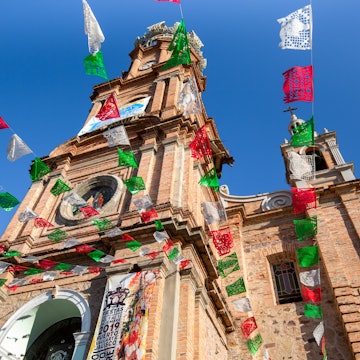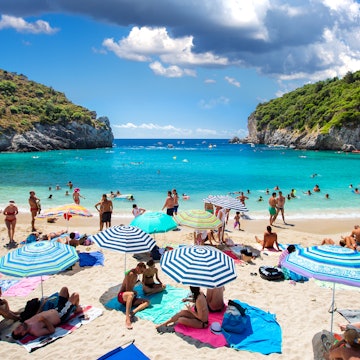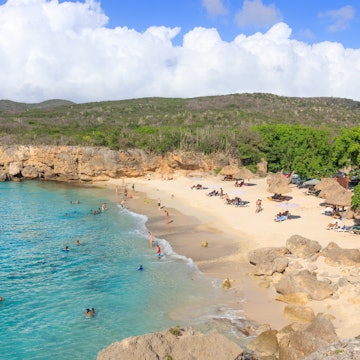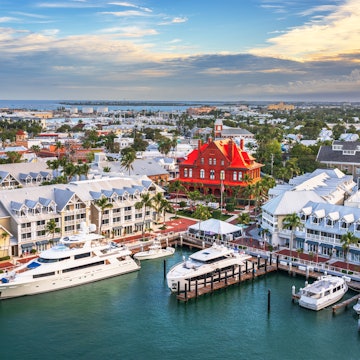

On the first night of the Dientes de Navarino trek in Chilean Patagonia, I lay in my tent with my sleeping bag pulled tightly closed around my face, shivering as the wind mercilessly whips through our campsite, making the sides of the tent flap hard, like a gull in a storm.

My legs ache, trying to recover from an intense day of sidling across a very steep mountainside covered in loose scree, snow and mud. A somewhat novice trekker, I had spent most of the afternoon slowly picking my way along the trail, with our guides keeping a watchful eye over my steps.
The mild panic that kept me clinging to that hillside lingers through the windy night at Laguna Salto, as we have been warned the next day was forecast to be even windier. Am I in too far over my head? Can I really do five days of this?
Spoiler alert: it turns out that I could, but the experience taught me a few things. Here’s what I learned when I hiked through one of the most remote landscapes on the planet.
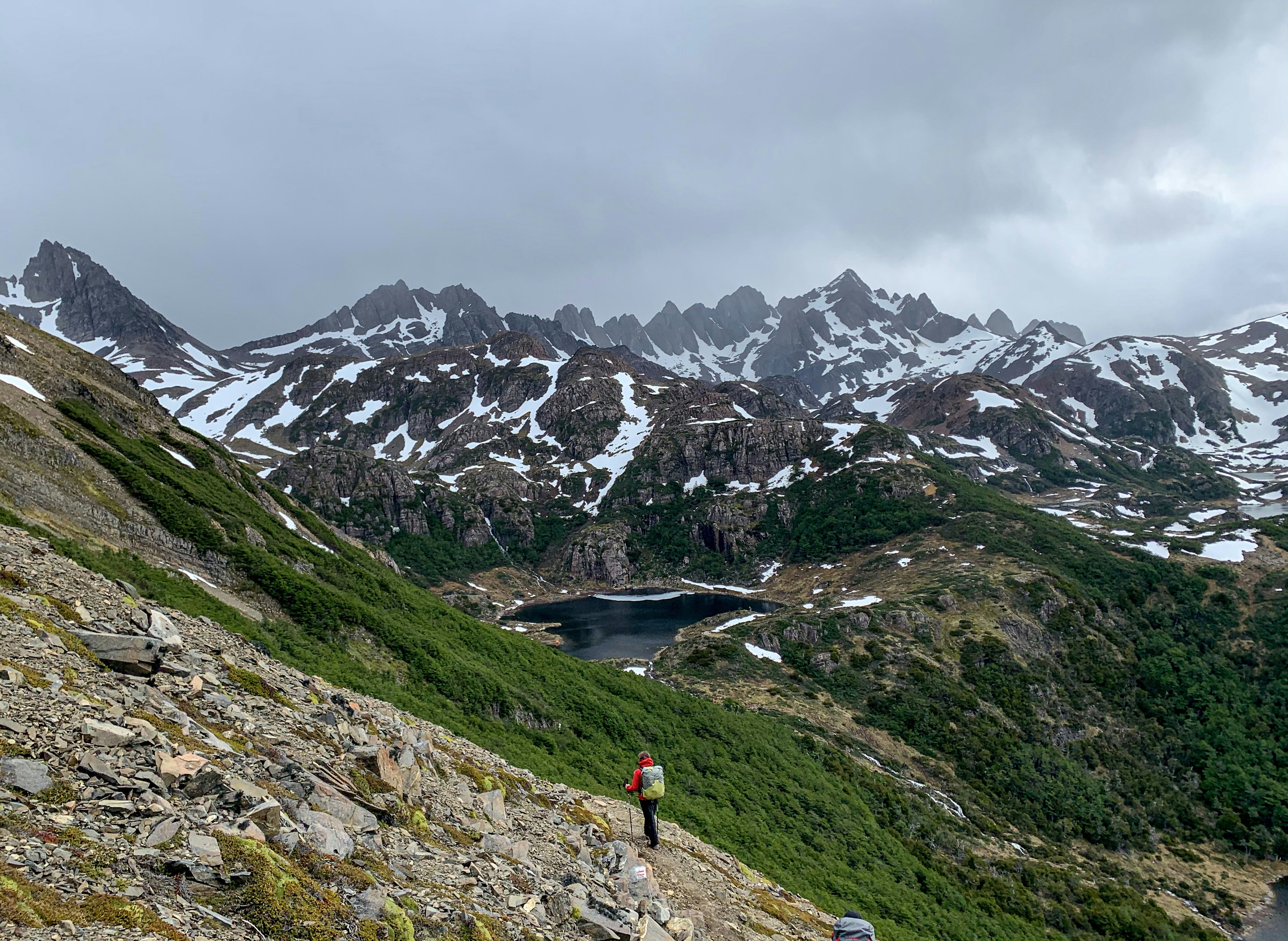
Hiking at the end of the world
Our first steps onto the trail take us through a damp forest full of tiny treasures that seem to come straight out of the pages of a fantasy novel – bright pink berries, chartreuse mosses and spherical tree-eating mushrooms the color of sherbet line the way until the forest suddenly changes. These new anemic trees give way to a martian expanse of broken rock that slips around beneath our boots. It’s here we get our first real glimpse of the jagged Dientes, a row of stone peaks as sharp as hound’s teeth pricking the cloudy sky. This trek takes us directly through the mountain range itself instead of hugging its base – here goes nothing.
Hiking at the end of the world presents a unique set of challenges. You are vulnerable and very far from anything familiar, carrying all the things that will keep you alive on your back. The weather here can change without warning, the violent Patagonian wind a constant reminder that we are small beings in an ancient, raw landscape that does not suffer fools. The trail itself cuts through unforgiving rock slopes, serious inclines and viscous muck, sometimes disappearing completely under a mischievous layer of snow. If you have something to prove to yourself, this is the place to do it.

Lesson one: the art of the thru-trek
The beautiful thing about doing a thru-trek is the ability to reach destinations that truly feel removed from reality – you are definitively in the wilderness. As a city-dwelling human whose livelihood revolves around the internet, I look at my email, check social media feeds, send text messages and stay otherwise connected 99.9% of the time. But not here.
On the Navarino trail, it’s just me. Its difficulty makes it hard to converse with the others along the way, so I keep to myself, finding the rhythm in a place so completely visual, auditory and tactile. Each pass opens to reveal a landscape unlike the one that came before it, a doorway to another Patagonian dimension: mood ring lagoons, coral-like yaretilla moss and beaver-scarred forests each tell their own story of survival in the polar tundra.

Small sensations define the time on the trail: the tic-tac of my hiking poles against the stone, the warm smell of the peat squelching beneath my boots, the ceramic tumble of loose rocks, the soft sting of ice hitting my face.
Usually, our world's relentless barrage of stimuli leaves me anxious and overwhelmed, but this is different; it's grounding. This trek is not just about unplugging, but instead plugging into something else. Something that feels honest and precious. It’s meditative, and this close attention becomes a practiced art over the course of the week. This is why people come and why they talk about the experience years later.
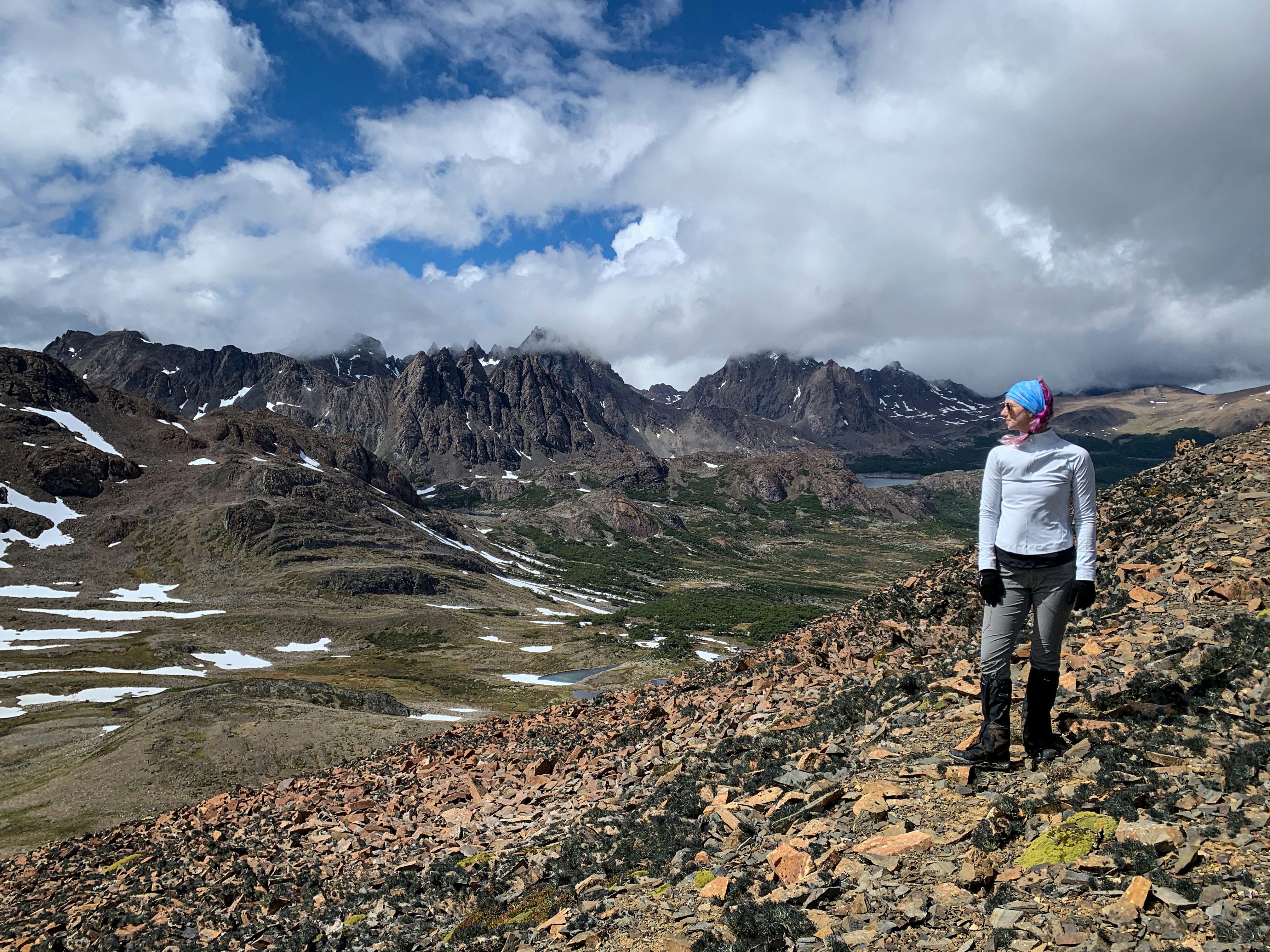
Lesson two: the importance of forgiving yourself
I curse under my breath as we walk around the bend hugging Laguna Escondida (Hidden Lake), a lake that – thanks to a few well-placed hillsides – is generally missing from Navarino’s panoramic views until you find it along the trail. The only way to navigate around the stunningly blue but very cold water is to pick your way through a series of jagged, medium-sized boulders, and these are wet from a brief ice storm.
At this point (day three), I have discovered that there are rocks that I like and rocks that I don’t like – gravel is the easiest, and while rock shards do slip around, it’s still fairly simple to walk. But these rocks are tricksters. They look solid and unmoving, but they unexpectedly shift underfoot and their broad surfaces deflect my hiking poles, sending them skittering into the spaces between them, where they catch and snag.

Worst of all, these rocks throw my inexperience with such terrain into sharp relief. My fellow hikers are far in front of me as I struggle on, sweating and gritting my teeth. One badly placed hiking pole leads to a misstep, another mistake, and then another. I apologize profusely to the porters behind me. Why can’t I do this? I’m just slowing everyone down. The boulders eventually give way to flat, squishy land, and later that day we take in incredible views from Paso Ventarrón that bring happy tears to my eyes.
As I stand on the pass, turning in circles trying to take in the huge breadth of it all, I realize: it’s okay. It’s okay that I did what I needed to do to get to this point – time to let go of expectations, both of my situation and of myself. Nobody judged my path but me, and the path was worth it.

Lesson three: the comedy of being uncomfortable
Every adventure advert and article out there (including some of mine) seems to peddle the image of the perfectly put-together, very serious outdoorsy person. The reality is that outdoor living has its very own undignified brand of humor. Whether you’re smacking your face into wet, smelly socks you’ve hung up in your tent to dry, realizing after a conversation that cold snot is running down your face, or making peace with the fact that you indeed are going to have to poop outside, it’s all a little funny.
And with this comedy comes a little grace. You can’t take yourself all that seriously when you’ve accidentally slid butt-first down a snowdrift or woken up with your hair sticking directly out from your face because you had to sleep with your hat on to keep warm. Humor beats frustration every time.
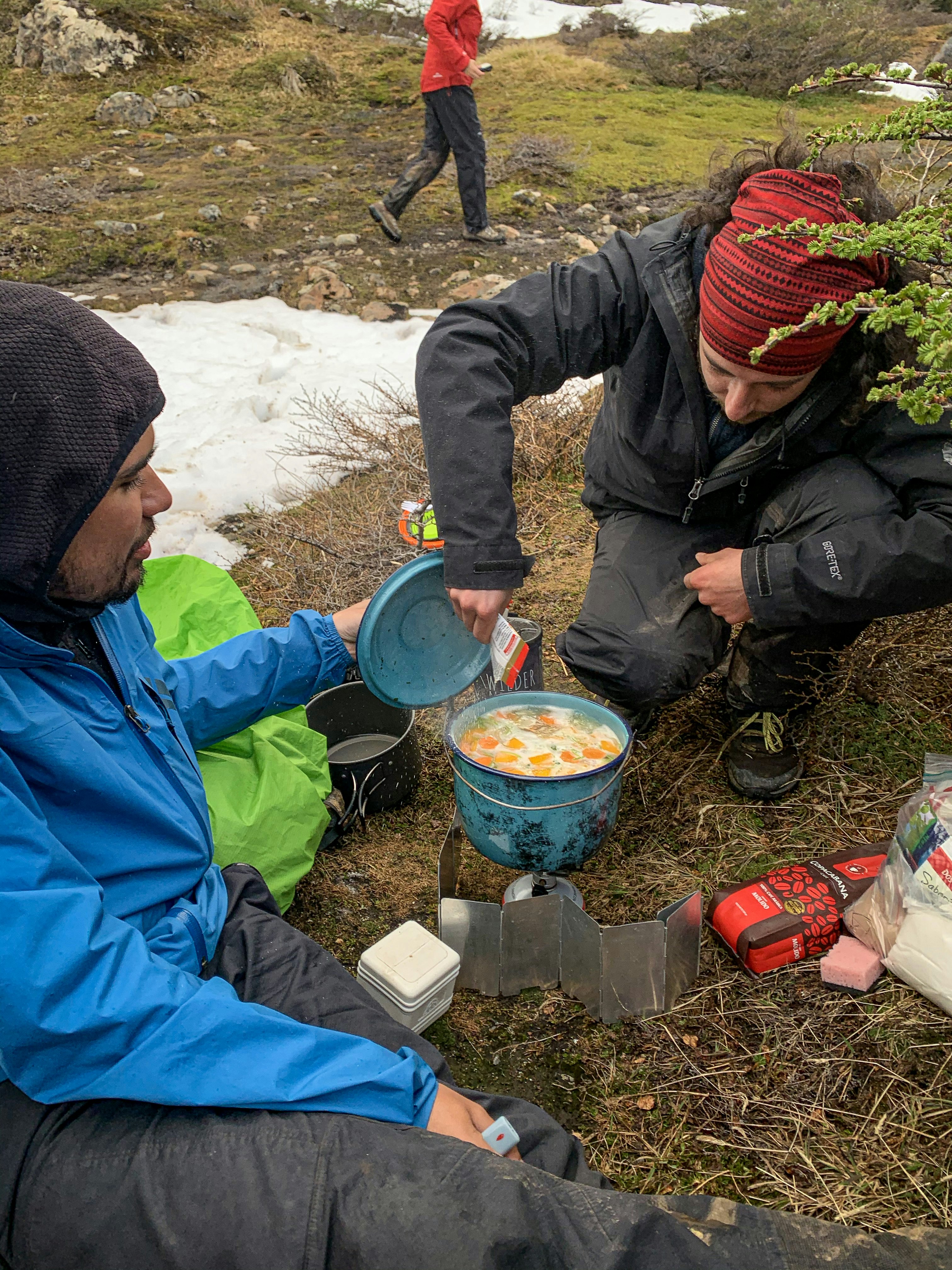
Lesson four: the value of camaraderie
Between all the mountain scaling and rock traversing are the evenings at the campsite. It’s here around the fire circle that you make your home and tap into those familiar ideas of comfort.
In the haze of the campfire smoke sits the crew enlisted to help our group move across Navarino. This team of porters and guides keep the trek safe, making sure we all stay on the vague suggestion of a trail and make it across the steep hills without any mishaps. When they aren’t in the Navarino mountains, Joshua is a mechanic and passionate skier; Cris, an amiable sommelier; and Pascal an enthusiastic YouTuber and avid outdoorsman. Matías is an ice climber and brand new dad, and Gonzalo a skilled photographer.
We learn about each other over steaming plates of chorizo and rice in the evenings and welcome cups of 'mountain coffee' in the mornings (“It’s not good, but it's good enough for the mountains!” jokes Cris). Nobody separates off. We stay by the fire, talking, even when it starts raining ice pellets. This sort of intimate gathering with strangers is a unique social experiment – you get to know everyone rather quickly in a short amount of time, and a shared experience gets even better. Take the time to engage with everyone on your trip, and you might walk away with some great new friends.

Lesson five: what’s in a summit?
“We’re going WHERE?” I holler, the 70mph wind tearing at my coat and pushing me backwards. We teeter on the top of Virginia Pass, the final major pass of the trek and the circuit’s highest point, overlooking a bowl of a valley so perfectly shaped that it's like someone took a giant scoop out of an ice cream tub. Matías points to a barely visible path snaking down the mountainside at a gradient that makes my eyes pop. Struggling to keep our footing against the wind, we headed down the slope single-file, digging our heels hard into the fine gravel to avoid sliding the whole way down.
As I maintain my death grip on my hiking poles, I see movement out of the corner of my eye. Pascal bounds down the hillside at breakneck speed like some sort of deer, nimbly navigating the terrain with the surefootedness that comes with routinely hiking one of the most intrepid paths in Chile. His joy is palpable, and my grip relaxes. Just a little.
At camp later that evening, we learn that Matías had rescued some hypothermic tourists stranded at the top of the pass in a sudden snowstorm just a week earlier, throwing the reality of our setting into harsh perspective. It’s a strange and sad realization that someone recently faced the very real prospect of dying along the same path you walked just hours prior. But that also could apply to any road you drive or sidewalk you walk, couldn't it? People are dealing with mortal battles all the time. Actually, there are summits everywhere.

The takeaway
The Dientes de Navarino trek is an exercise in both strength and humility. It squarely makes you aware of your humanity while showing you the natural magnificence of a place so rarely seen. Here, you learn a lot about yourself, about others and about the sheer power of our planet. Do I recommend the experience? Absolutely. Just be prepared for a personal reckoning that sticks with you long after you’ve arrived home.
You might also like:
The 10 best treks in the world
How to be sustainable on your hiking trip
We tested boots, backpacks and more in Patagonia – here’s what we learned
Bailey Freeman travelled to Chile with support from the Chilean Tourism Board. Lonely Planet contributors do not accept freebies in exchange for positive coverage.










